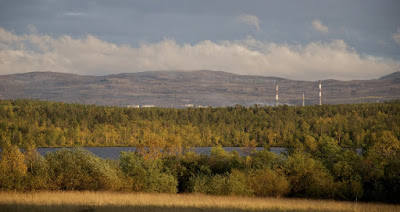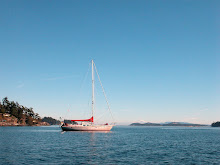By day three of our transit down Hinlopen Strait, we were feeling confident about making it through. After spending the previous two days trying to gain ground against the wind, Snow Dragon found herself enjoying a nice northerly breeze and was happily sailing downwind with little ice to worry about.
The view was humbling as we glided along Valhalifonna Glacier with its vast ice cliff staring down at us. Over four miles long, Valhalifonna was one of the most impressive glaciers that we have seen. Even the fog that began to set in could not detract from its powerful presence.

After the wall of ice and fog came the bird cliff Alkefjella. Birds filled the air around their favored nesting place. While others stopped for a rest on the drift ice which was becoming more prevalent as we continued south. Scanning the cliff, we saw an ambitious polar bear climbing the steep rock in search of eggs. The snow had almost disappeared from the cliff face and the intense green that took its place made it easy to spot the white bear.
Towards the end of our day the terrain changed to dark, spiky volcanic rock. From an aesthetic point of view it was nice to see the dramatic change in landscape but the random variation in the contours continued underneath the water. Not only is good holding difficult to find with an uneven bottom, sudden dramatic changes in depth make looking for a spot potentially hazardous in an incompletely charted area.
We made several abortive attempts before finding consistent depth in the lee of the island Von Otter Oya near Hinlopen Glacier. After setting the anchor at midnight, we stayed up for a few hours to enjoy the bright sunlight and to unwind from the previous twelve hours of great sailing before going to sleep. Everything seemed peaceful but thirty minutes after we went to bed, a loud bang shook the boat and Krystina got up to find several ice sheets pushing against Snow Dragon. Frances immediately went out to pull the anchor and Krystina could hear the ice pushing up underneath Snow Dragon’s bow as she stowed the chain in the forepeak.

Anchorage at Von Otter Oya, shortly after leaving.
Getting the anchor up from underneath the ice turned out to be the easy part. Our first instinct was to analyze the situation and come up with a course of action but when Krystina glanced over her shoulder and saw fog rolling in from the north, moving quickly become our only option. The last thing we needed was to be in a whiteout with ice pushing us towards land and not be able to see a lead through.
Using her engine, Snow Dragon plowed away from the island before visibility decreased. Once a safe distance from land, she began picking through ice under sail. Our senses were on overload trying to listen for other ships and find leads. After five hours we sailed out of the fog and though the density of the ice was greater, it was much easier to see where we needed to go.

Frances managed to get a short nap but Krystina’s was cut short when Snow Dragon got stuck in the ice while under sail. She had firmly nestled herself into a large ice sheet that turned out not to be breakable. Though turning the engine on and reversing detached Snow Dragon from the ice’s embrace, it became evident that both of us needed to be on deck. One behind the wheel and the other scoping out leads from the foredeck, trying to differentiate between solid and breakable ice. Candy, copious amounts of tea and the concentration demanded by the task at hand, helped keep us awake.
Though sleep was a constant thought, it did not prevent us from appreciating our surroundings. The sky was alive with color. Amongst the blue, bands of yellow and orange brightening the horizon. While the fog helped to emphasize Svalbard’s subtle beauty, drawing our attention to intricate, sculptural detail in the ice that confronted Snow Dragon.
After twenty hours of pretending to be an icebreaker, the ice became manageable and we began looking for another anchorage. The north side of Barentsoya looked like a good spot. Shortly after settling in, the ice drifted down on us, leaving no choice but to keep moving.
We spotted Antarctic Dream, an expedition ship, and called them on the radio to see if they had a current ice report. They did and according to the latest ice chart, Hinlopen Strait and Freemansund were open water. Snow Dragon had been in ice up to eighty percent in Hinlopen and Antarctic Dream just to the east, was in fifty percent ice. After exchanging our views on the accuracy of the ice chart we continued to head for Freemansund, the passage between Barentsoya and Edgeoya, not knowing what we would find.
Forty hours after leaving our anchorage by Valhalifonna Glacier, we finally found a spot near Freemansund, on the east side of Barentsoya where we could safely stop and rest. Before dropping anchor Frances got the net out and retrieved a few small pieces of ice from the water for celebratory drinks. After toasting Dick Koopmans, for designing an amazing boat that always exceeds our high expectations, we enjoyed our much needed rest.
For more photos of Hinlopen Strait please click on Hinlopen Album.































